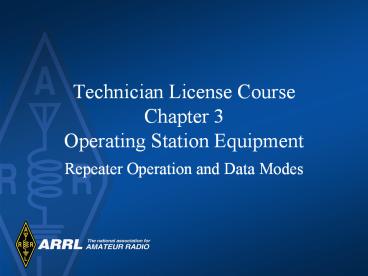Technician License Course Chapter 3 Operating Station Equipment - PowerPoint PPT Presentation
1 / 16
Title:
Technician License Course Chapter 3 Operating Station Equipment
Description:
Title: PowerPoint Presentation Author: DSZLACHETKA Last modified by: tbaker Created Date: 7/28/2005 2:19:34 PM Document presentation format: On-screen Show – PowerPoint PPT presentation
Number of Views:111
Avg rating:3.0/5.0
Title: Technician License Course Chapter 3 Operating Station Equipment
1
Technician License CourseChapter 3Operating
Station Equipment
- Repeater Operation and Data Modes
2
What is a Repeater?
- Specialized transmitter/receiver interconnected
by computer controller - Generally located at a high place
- Receives your signal and simultaneously
re-transmits your signal on a different frequency - Dramatically extends line-of-sight range
- If both users can see the repeater site
3
(No Transcript)
4
A Little Vocabulary First
- Simplex
- Transmitting and receiving on the same frequency
- Each user takes turns to transmit
- Is the preferred method if it works
5
A Little Vocabulary First
- Duplex
- Transmitting on one frequency while
simultaneously listening on a different frequency - Repeaters use duplex
- Output frequency the frequency the repeater
transmits on and you listen to - Input frequency the frequency the repeater
listens to and you transmit on
6
Things to Know to Use a Repeater
- Output frequency
- Frequency split
- and therefore the input frequency
- Repeater access tones (if any)
7
Repeater Output Frequency
- Repeaters are frequently identified by their
output frequency - Meet you on the 443.50 machine.
- Here the specific frequency is used
- Lets go to 94.
- Here an abbreviation for a standard repeater
channel is used meaning 146.94 MHz - How about the NARL repeater?
- Here the repeater is referenced by the sponsoring
club name
8
Repeater Frequency Split
- The split, shifts, or offset frequencies are
standardized to help facilitate repeater use - There are and shifts depending on the plan
- Different bands have different standardized
amounts of shift
9
Repeater Access Tones
- Sometimes multiple repeaters can be accessed at
the same time unintentionally - To preclude unintentional access, some repeaters
require a special sub-audible tone to be present
before the repeater controller will recognize the
signal as a valid signal and turn on the repeater - These tones are called by various names
(depending on equipment manufacturer) - CTCSS
- PL
- Privacy codes or tones
10
Repeater Access Tones
- Access tones are usually published along with
repeater frequencies - Could also be announced when the repeater
identifies - PL is 123.0
- Tones are generally programmed into the radio
along with frequency and offset
11
Repeater Controller
- Computer that controls the repeater operation
- Station identification (Morse code or synthesized
voice) - Same ID requirements as you have
- Time-out protection
- Sometimes called the alligator
- Protects against continuous transmission in the
event of a stuck PPT or long winded hams - Courtesy tone repeater time-out timer reset
12
Data Modes
- Connecting computers via ham radio
- Some systems use radio to connect to Internet
gateways - The bulk of the work is done by specialized
modems or computer software/sound card - Terminal Node Controller (TNC)
- Multiple Protocol Controller (MPC)
13
TNC MPC
- Provide digital interface between computer and
radio - Package the data into proper format
- Convert digital data into audio tones
representing 1s and 0s of digital data - Send/receive tones to transceiver
- Control the transceiver
14
Data Station Setup
15
Review Test Questions
- T5B08
- T5C03, 05-08
- T5A08-10
- T6A03
16
Next Time
- Antenna Systems
- Read 3-12 through 3-23






























